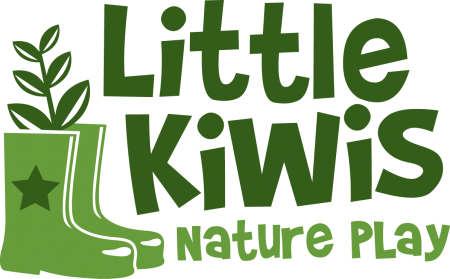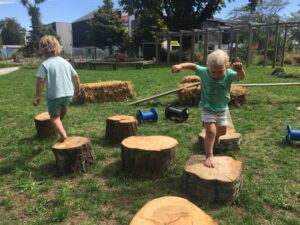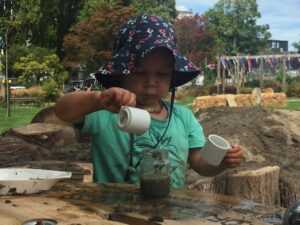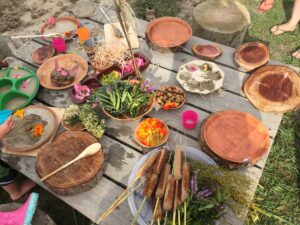Loose parts are an essential element in any play setting creating opportunities for children’s creativity, problem-solving and cognitive development.
When I think back to my childhood, I can remember some of my own play experiences and the loose parts scattered throughout that play.
I didn’t know them as loose parts then, they were just things that we played with.
We would find them around the house, in the shed or in a pile destined for the dump. Some people would call it junk!
We used them in multiple ways. They were versatile and could change form when we needed them to be something else. Unlike a toy car which is, well, just that. A toy car.
What are Loose Parts?
In play, loose parts are open-ended materials that can be used in multiple ways. They can be moved, manipulated, carried, transformed, redesigned, taken apart and put back together [1].
They are man-made or natural everyday items that do not come with a set of instructions. The possibilities are endless.
Loose parts can be small items or large. Things like boxes, wood, cable reels, sticks, blocks, cylinders, nuts like acorns, foliage, cushions, baskets, wheelbarrows, dirt, ropes, bags, buckets and trolleys are just some examples of the myriad of objects or materials we refer to as loose parts.
What are the Benefits of Loose Parts Play?
Loose parts in a play environment enable and support child-led play. Having loose parts available in a play space allows children to get creative and use the materials as they choose.
When children are playing with loose parts we will see schema theory in there too. The two go hand in hand. Schema is the technical term for play urges and refers to repeated patterns of behaviour. Read more about schema here.
Having loose parts available in the outdoor environment such as logs, planks and cable reels encourages active outdoor play. Active outdoor play offers children more opportunities for free play, and affordances to enhance not only their physical activity but other aspects of growth and development [2,3].
Current evidence on loose parts play describes how the open-endedness of these materials promotes creativity, imagination and problem-solving and adds to children’s cognitive development [4].
There is a wide range of cognitive and socio-emotional benefits, including happiness at school, social benefits and enhanced exploratory, creative and dramatic play [5,6,7,8].
When children have exposure to intriguing loose parts, they become curious. This sense of curiosity is how children become inspired to engage in new explorations and discoveries [9].
Loose parts can also encourage children to explore their environments, take risks during their play, and develop confidence and motivation [10]. Let us not forget that loose parts help facilitate communication and negotiation skills when added to an outdoor space [11].
Often you will find that children would rather play with loose parts that they can use and adapt as they please, instead of expensive pieces of play equipment. Not only are loose parts affordable, but they are also a sustainable choice.
Getting Started with Loose Parts
Once you understand what loose parts are and how they support a child’s development the first step is sourcing your loose parts.
1. Brainstorm
Make a list of possible resources that would suit your play environment. Split the list into large and small. You can also add where you might be able to source that loose part e.g. an electrical warehouse for wooden cable reels or a tree in the local park with lots of interesting nuts and seed pods to collect in summer.
2. Gather
Share your list of possible loose parts with your community/families and invite them to hunt them out. You can also share your wishlist on neighbourhood or community web pages. Be specific regarding material requests e.g. I am looking for logs that have been cut up and are approximately 40cm in diameter and 40cm in height. You are looking for usable materials in good working condition.
3. Designate Space
Think about how loose parts will be used in your environment. Will they be free to go anywhere or do you want to have a designated loose parts play area? How will you define that space? Whom will you involve in those conversations? Top tip – talk to the children and involve them in the decision-making.
4. Rules
You will need to set the culture of the loose parts play zone. What are the ground rules that the children agree to? How do they want to engage in the designated space? Top tip – have a conversation about ownership of loose part structures. Having ownership such as “this is our hut and you can’t play in it” can cause problems long term. Some places have rules like each day is a new day so your structure and loose parts from yesterday can be used by anyone today.
5. Storage
Think about how you are going to store your loose parts. Will some of the larger ones stay outside or will they need to be put away? Will you need a small shed, a trolley that gets pulled out, boxes on shelves?
6. Replenish
Replenishing, resorting, repairing and retiring loose parts is an ongoing job. Have a couple of people responsible for checking materials for damage or wear and tear, updating your loose parts list and replacing items. This will be a great help in making sure your space has enough loose parts all the time. Remember to lean on your community for the sourcing of replacement or new loose parts.
The Role of the Adult in Loose Parts Play
The adult role in loose parts play could be different from what you are used to. Here are some top tips for adults in loose parts play:
- Create an environment that isn’t overwhelming and where children feel empowered to lead their own play.
- Resource the environment with a variety of loose parts and enough loose parts to enable endless possibilities.
- Observation is a key role. Watch how the children are playing, what they are playing with and the types of play that are going on. Resist the urge to offer suggestions, run activities or interfere with disagreements.
- Information gathered from observation should be used to support future play either through additional resources, provocations or sourcing specific resources that the children are wanting aka goffer!
- Manage safety. Large loose parts often lead to risky play which is a normal and necessary element of a child’s development. To support this check equipment regularly and check for hazards that the children haven’t seen yet.
- Only step in if there is potential for significant harm or if a disagreement looks like someone will get physically hurt or if it is escalating to a place where additional support is required.
- Wear a variety of hats from facilitator, goffer, player, observer, play enhancer, and resource provider. Policing, controlling and Judging roles don’t fit in with a loose parts philosophy.
Loose parts seem to allow children to get deep into their play and they tend to be engaged for longer periods. There is just so much thinking going on.
Allowing children to lead their play and letting them choose how they want to engage with loose parts is a wonderful way we can help grow and develop our children’s brains.
Celia Hogan, Founder of Little Kiwis Nature Play is a Nature Education Specialist, Consultant, Speaker, Writer and Parenting Coach. She is passionate about connecting children to nature and is a strong advocate for nature play, risky play and improving mental health and well-being through nature. Check out her articles on all things nature and child development and find workshops, online courses and resources on her website.
RESEARCH
- Nicholson, S. 1971. How not to cheat children: theory of loose parts. Landscape Architecture.
- Gray C, Gibbons R, Larouche R, et al. 2015. What is the relationship between outdoor time and physical activity, sedentary behaviour, and physical fitness in children? A systematic review. Int J Environ Res Public Health. PubMed
- Veitch J, Bagley S, Ball K, et al. 2006. Where do children usually play? A qualitative study of parents’ perceptions of influences on children’s active free-play. Health Place. PubMed
- Gibson JL, Cornell M, Gill T. 2017. A systematic review of research into the impact of loose parts play on children’s cognitive, social and emotional development. Sch Ment Health. PubMed
- Houser NE, Roach L, Stone MR, et al. 2016. Let the children play: Scoping review on the implementation and use of loose parts for promoting physical activity participation. AIMS Public Health. PubMed
- Gibson JL, Cornell M, Gill T. 2017 A systematic review of research into the impact of loose parts play on children’s cognitive, social and emotional development. Sch Ment Health. PubMed
- Flannigan C, Dietze B. 2017. Children, outdoor play, and loose parts. J Child Stud. Google Scholar
- Sutton MJ. 2011. In the Hand and Mind: The intersection of loose parts and imagination in evocative settings for young children. Child Youth Environ. Google Scholar
- Perry, B. 2004. Maltreatment and the developing child: How early childhood experience shapes child and culture. Retrieved from http://www.lfcc.on.ca/mccain/perry.pdf
- Casey T, Robertson J. 2017. Loose Parts Play: A toolkit. Inspiring Scotland, Edinburgh. 2016. Retrieved from: https://www.inspiringscotland.org.uk/wp-content/uploads/2017/03/Loose-Parts-Play-web.pdf.)
- Maxwell, Mitchell and Evans. Effects of play equipment and loose parts on preschool children’s outdoor play behaviour: An observational study and design intervention. https://www.jstor.org/stable/10.7721/chilyoutenvi.18.2.0036







Celia keep up your amazing work inspiring myself n others .. while I walk your talk every time I read your comments I become refreshed when the body is a bit of lack lustre ..Thankyou so very much !!
How did I miss this lovely comment 🙂 Thanks so much Sue and I am so pleased that these articles refresh you. Many thanks.
Celia